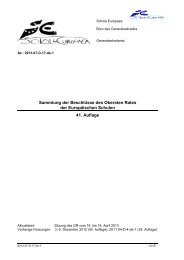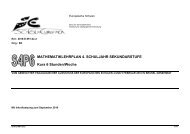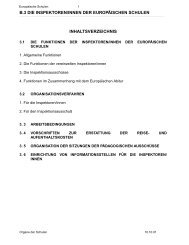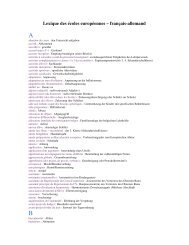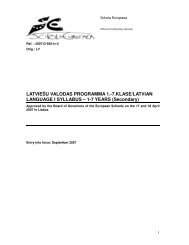External Evaluation of the European Baccalaureate (Annexes)
External Evaluation of the European Baccalaureate (Annexes)
External Evaluation of the European Baccalaureate (Annexes)
You also want an ePaper? Increase the reach of your titles
YUMPU automatically turns print PDFs into web optimized ePapers that Google loves.
ANALYSIS<br />
Real<br />
functions<br />
<strong>of</strong> a real<br />
variable<br />
Continuity<br />
and limits<br />
<strong>of</strong> complex numbers<br />
• Complex conjugates<br />
• Operations on complex<br />
numbers<br />
• Reciprocal <strong>of</strong> non-zero<br />
complex number<br />
• Square roots <strong>of</strong> a<br />
complex number<br />
• Solution <strong>of</strong> quadratics<br />
with complex coefficients<br />
• Geometric representation<br />
<strong>of</strong> a complex number<br />
• Trigonometric form<br />
• Modulus <strong>of</strong> a complex<br />
number, <strong>of</strong> a product and<br />
<strong>of</strong> a quotient<br />
• Argument <strong>of</strong> a non-zero<br />
complex number, <strong>of</strong> a<br />
product, <strong>of</strong> a quotient<br />
• Powers, nth roots<br />
• De Moivres <strong>the</strong>orem<br />
• Definition <strong>of</strong> a real function<br />
• Domain <strong>of</strong> a function<br />
• Zeros <strong>of</strong> a function, sign <strong>of</strong> a<br />
function<br />
• Even and odd functions<br />
• Periodic functions<br />
• Composition <strong>of</strong> two functions<br />
• Inverse <strong>of</strong> a bijection<br />
• Increasing and decreasing<br />
functions, constant, monotonic,<br />
over an interval. Local and<br />
global extrema<br />
• Graph <strong>of</strong> a function<br />
Year 7<br />
• Apply <strong>the</strong> above to absolute<br />
value, polynomials, rational<br />
functions and those involving<br />
square roots<br />
• Circular functions<br />
• Natural logarithm functions<br />
• Exponential function with base<br />
e<br />
• Functions obtained by addition,<br />
multiplication , division or<br />
composition<br />
• Notion <strong>of</strong> continuity <strong>of</strong> a<br />
function at a point<br />
• Continuity <strong>of</strong> a function from<br />
<strong>the</strong> right<br />
• Continuity <strong>of</strong> a function over an<br />
open interval<br />
• Statement without pro<strong>of</strong> <strong>of</strong><br />
<strong>the</strong>orems concerning continuity<br />
– <strong>of</strong> <strong>the</strong> absolute value <strong>of</strong> a<br />
continuous function<br />
51<br />
numbers<br />
• Complex conjugates<br />
• Operations on complex numbers<br />
• Argand diagram<br />
• Two square roots <strong>of</strong> complex numbers<br />
• Illustrate simple equations and<br />
inequalities involving complex<br />
numbers by means <strong>of</strong> loci in an<br />
Argand diagram<br />
FP2<br />
• Multiplication and division <strong>of</strong> two<br />
complex number expressed in polar<br />
form<br />
• Understand De Moivres <strong>the</strong>orem<br />
• Find and use nth roots <strong>of</strong> unity<br />
• Use expression for sine θ and Cos θ in<br />
expressing powers <strong>of</strong> sine θ and Cos θ<br />
in terms <strong>of</strong> multiple angles and<br />
summing series<br />
C1<br />
• Understand and use <strong>the</strong> relationship<br />
between <strong>the</strong> graphs <strong>of</strong> y = f(x), y=a f(x),<br />
y=f(x) +a y = f( x + a), y = f(ax) express in<br />
terms <strong>of</strong> translations, reflections and<br />
stretches<br />
C3<br />
• Understand terms function, domain, 1 to<br />
1 function, inverse function an<br />
composition <strong>of</strong> functions<br />
• Identify <strong>the</strong> range <strong>of</strong> a functions<br />
• Illustrate in graphical terms <strong>the</strong> relation<br />
between 1 to 1 functions and its inverse<br />
• Understand <strong>the</strong> meaning <strong>of</strong> |x|<br />
• Understand <strong>the</strong> relationship between <strong>the</strong><br />
graphs <strong>of</strong> y=f(x) and y=|f(x)|<br />
• Use and recognise <strong>the</strong> compositions <strong>of</strong><br />
transformations <strong>of</strong> graphs<br />
• Understand <strong>the</strong> properties <strong>of</strong> exponential<br />
and logarithmic functions and <strong>the</strong>ir<br />
graphs<br />
• Understand exponential growth and<br />
decay



